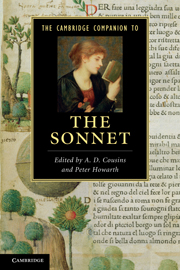Book contents
- Frontmatter
- Introduction
- 1 Contemporary poets and the sonnet
- 2 The sonnet and the lyric mode
- 3 The sonnet, subjectivity and gender
- 4 The English sonnet in manuscript, print and mass media
- 5 European beginnings and transmissions
- 6 Desire, discontent, parody
- 7 Shakespeare’s Sonnets
- 8 Sacred desire, forms of belief
- 9 Survival and change: the sonnet from Milton to the Romantics
- 10 The Romantic sonnet
- 11 The Victorian sonnet
- 12 The modern sonnet
- 13 The contemporary sonnet
- Further reading
- Index
4 - The English sonnet in manuscript, print and mass media
Published online by Cambridge University Press: 28 May 2011
- Frontmatter
- Introduction
- 1 Contemporary poets and the sonnet
- 2 The sonnet and the lyric mode
- 3 The sonnet, subjectivity and gender
- 4 The English sonnet in manuscript, print and mass media
- 5 European beginnings and transmissions
- 6 Desire, discontent, parody
- 7 Shakespeare’s Sonnets
- 8 Sacred desire, forms of belief
- 9 Survival and change: the sonnet from Milton to the Romantics
- 10 The Romantic sonnet
- 11 The Victorian sonnet
- 12 The modern sonnet
- 13 The contemporary sonnet
- Further reading
- Index
Summary
As communication theorists have repeatedly observed, each medium meta-communicatively defines the nature of the messages being transmitted as well as the relationship between their senders and receivers. It matters whether one encounters texts in oral, handwritten, printed or electronic forms. It also matters whether the texts are spoken or sung; recorded by amateur or professional scribes, either in inelegant or presentationally artful forms; published in ephemeral pamphlets, newspapers or magazines; printed in paperback or hardback books; experienced on radio, television, film, tape, records, CDs or DVDs; or found in various forms of casual or institutionally mediated emails and websites. Finally, the cultural context is crucial: the oral or written (scripted and/or printed) or electronic and visual modalities dominant in the world in which texts are transmitted shape the different kinds of relationships their originators and receivers have to them. Marshall McLuhan’s assertion that ‘the medium is the message’ was a provocative overstatement, but it is certainly true that messages are inseparable from the media through which they are transmitted, and the mediated message in its material, rather than ideal, form is the one that is experienced in particular ways. And so there is no culturally faithful history of a literary form such as the sonnet without considering the communicative channels through which such poetry flowed through the late medieval, early modern, modern and postmodern eras. This is true of the general history of the form as well as of that of the sonnet in the anglophone world.
- Type
- Chapter
- Information
- The Cambridge Companion to the Sonnet , pp. 66 - 83Publisher: Cambridge University PressPrint publication year: 2011
- 1
- Cited by



